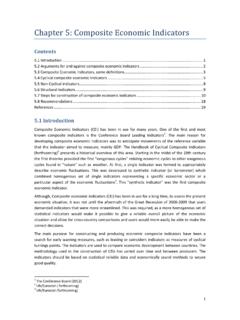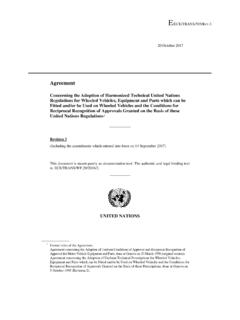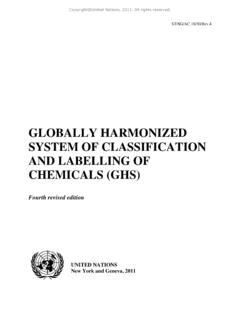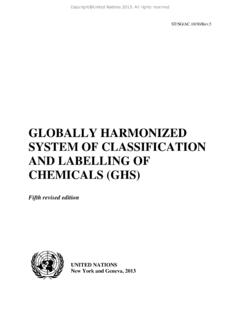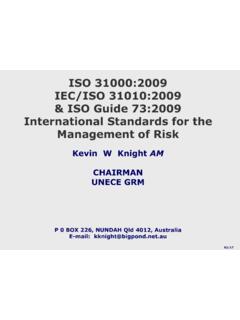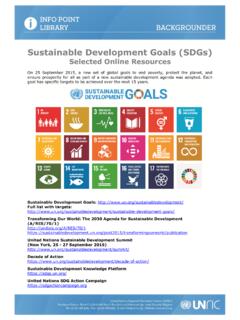Transcription of UN Regulation No 129 - UNECE
1 UN Regulation No 129 Increasing the safety of children in vehiclesFor policymakers and concerned citizensCover illustration credit: - SIAS/ItalyUNITED nations economic commission FOR EUROPEUN Regulation No 129 Increasing the safety of children in vehiclesFor policymakers and concerned citizens2UN Regulation No 129 united nations economic commission for EuropeThe united nations economic commission for europe ( UNECE ) is one of the five united nations regional commissions, administered by the economic and Social Council (ECOSOC). It was established in 1947 with the mandate to help rebuild post-war europe , develop economic activity and strengthen economic relations among European countries, and between europe and the rest of the world.
2 During the cold war, UNECE served as a unique forum for economic dialogue and cooperation between East and West. Despite the complexity of this period, significant achievements were made, with consensus reached on numerous harmonization and standardization the post-cold-war era, UNECE acquired not only many new member States, but also new functions. Since the early 1990s the organization has focused on analyzing the transition process, using its harmonization experience to facilitate the integration of Central and Eastern European countries into the global is the forum where the countries of Western, Central and Eastern europe , Central Asia and North America 56 countries in all come together to forge the tools of their economic cooperation.
3 That cooperation concerns economics, statistics, environment, transport, trade, sustainable energy, timber housing and land management. UNECE offers a regional framework for the elaboration and harmonization of conventions, norms and standards. The experts of UNECE provide technical assistance to the countries of South-East europe and the Commonwealth of Independent States. This assistance takes the form of advisory services, training seminars and workshops where countries can share their experiences and best the safety of children in vehicles For policymakers and concerned citizens Transport in UNECEThe UNECE Sustainable Transport Division is the secretariat of the Inland Transport Committee (ITC) and the ECOSOC Committee of Experts on the Transport of Dangerous Goods and on the Globally Harmonized System of Classification and Labelling of Chemicals.
4 The ITC and its 17 working parties, as well as the ECOSOC Committee and its sub-committees are intergovernmental decision-making bodies that work to improve the daily lives of people and businesses around the world, in measurable ways and with concrete actions, to enhance traffic safety, environmental performance, energy efficiency and the competitiveness of the transport ECOSOC Committee was set up in 1953 by the Secretary-General of the united nations at the request of the economic and Social Council to elaborate recommendations on the transport of dangerous goods.
5 Its mandate was extended to the global (multi-sectoral) harmonization of systems of classification and labelling of chemicals in 1999. It is composed of experts from countries which possess the relevant expertise and experience in the international trade and transport of dangerous goods and chemicals. Its membership is restricted in order to reflect a proper geographical balance between all regions of the world and to ensure adequate participation of developing countries. Although the Committee is a subsidiary body of ECOSOC, the Secretary-General decided in 1963 that the secretariat services would be provided by the UNECE Transport is a unique intergovernmental forum that was set up in 1947 to support the reconstruction of transport connections in post-war europe .
6 Over the years, it has specialized in facilitating the harmonized and sustainable development of inland modes of transport. The main results of this persevering and ongoing work are reflected, in among other things, (i) 58 united nations conventions and many more technical regulations, which are updated on a regular basis and provide an international legal framework for the sustainable development of national and international road, rail, inland water and intermodal transport, including the transport of dangerous goods, as well as the construction and inspection of road motor vehicles; (ii) the Trans-European North-south Motorway, Trans-European Railway and the Euro-Asia Transport Links projects, that facilitate multi-country coordination of transport infrastructure investment programmes; (iii) the TIR system, which is a global customs transit facilitation solution.
7 (iv) the tool called For Future Inland Transport Systems (ForFITS), which can assist national and local governments to monitor carbon dioxide (CO2) emissions coming from inland transport modes and to select and design climate change mitigation policies, 4UN Regulation No 129based on their impact and adapted to local conditions; (v) transport statistics methods and data that are internationally agreed on; (vi) studies and reports that help transport policy development by addressing timely issues, based on cutting-edge research and analysis. ITC also devotes special attention to Intelligent Transport Services (ITS), sustainable urban mobility and city logistics, as well as to increasing the resilience of transport networks and services in response to climate change adaptation and security challenges.
8 In addition, the UNECE Sustainable Transport and Environment Divisions, together with the World Health Organization (WHO) europe , co-service the Transport Health and Environment Pan-European Programme (THE PEP).Finally, as of 2015, the UNECE Sustainable Transport Division is providing the secretariat services for the Secretary General s Special Envoy for Road Safety,Mr. Jean :The realization of the brochure was supported by: (i) the German Federal Ministry of Transport and Digital Infrastructure and the Federal Highway Research Institute (BASt) who contributed main parts of the brochure, (ii) the European Association for the Co-ordination of Consumer Representation in Standardisation (ANEC) and (iii) the European Association of Automotive Suppliers (CLEPA).
9 Inland Transport Committee (ITC) Centre of united nations Transport Conventions5 Increasing the safety of children in vehicles For policymakers and concerned citizens To reduce the risk of severe injuries in the case of accidents, it is important that babies and toddlers are transported opposite the driving direction for as long as possible. Compared to older children and adults, they have weaker neck muscles carrying a relatively large and heavy head. A premature change into a forward-facing Child Restraint System (CRS) increases the risk of severe injury to the cervical spine in case of accidents. A rearward facing CRS is too small if the child s head is on the same height or above the upper edge of the shell, or if the child has exceeded the weight approved for the group.
10 The use of a rearward facing CRS on a vehicle seat with activated passenger airbag is prohibited by law due to the danger to the child. It is suggested that the vehicle manual is consulted in order to determine whether a CRS may be placed on the passenger seat and how the airbag can be deactivated, if necessary. The new UN Regulation No. 129, also known as i-Size Regulation , has been developed in order to better address issues such as the one described has been developed by the Working Party on Passive Safety (GRSP), a subsidiary body of the World Forum for Harmonization of Vehicle Regulations ( )of the united nations economic commission for europe ( UNECE ), with the aim of enhancing child safety in europe .

